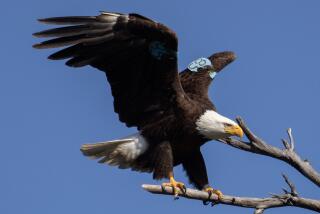Animal Park Worried About New Condor Egg’s Shell
- Share via
An egg laid Sunday by the last female California condor in the wild was snatched Tuesday from a nest near Ventura and airlifted to the San Diego Wild Animal Park in the continuing effort to rescue the acutely endangered species.
But condor specialists were less than optimistic about the egg’s prospects because recent lab tests on fragments of the mother’s previous egg showed that it contained the highest levels of pesticide ever found in a condor egg.
The pesticide, a breakdown product of DDT, is believed to have made the previous egg extraordinarily fragile. That egg shattered last month under the weight of the parents. It was the only other condor egg believed to have been laid in the wild during the 1986 breeding season.
“The egg is being handled very gingerly,” Jeff Jouett, a spokesman for the San Diego Zoo, said Tuesday. “We’re not sure how thin the shell is or how that might affect its chances of surviving until hatching.”
Members of the California condor recovery team took the second egg from the Sespe condor sanctuary near Ventura early Tuesday. They placed it in a heavily padded and temperature-controlled suitcase and brought it by helicopter to the Wild Animal Park near Escondido.
There, condor specialists determined that it was intact and apparently fertile and that the shell did not appear dangerously thin. The egg will be kept in an incubator in the hope that it will hatch in about 54 days.
The egg, which is blue and weighs 7.3 ounces, is the 16th received since 1983 by the Wild Animal Park, which is working with the San Diego and Los Angeles zoos to preserve the species. Condors from 12 of those eggs are now at the zoos. Two others died upon hatching, and one egg never hatched.
Last month, the recovery team discovered that a new breeding pair had established itself among the five remaining birds in the wild. But the team also found that the pair’s first egg had cracked before team members could bring it into captivity.
Lab tests showed the egg contained 180 parts per million of DDE, a breakdown product of DDT, authorities said Tuesday. DDT, which is banned, is known to cause eggshell thinning in wild birds.
Martha Baker, a Wild Animal Park spokesman, said the adult female condor might lay another egg this breeding season, because she has laid three in past seasons. “It’s fairly late for her to lay another one, but there’s always a possibility,” Baker said.
California condors once ranged over most of western North America and as far east as Florida. But loss of habitat and the spread of pesticides, poisons and lead shot have left only five in the wild and 21 in the Wild Animal Park and zoos.
More to Read
Sign up for Essential California
The most important California stories and recommendations in your inbox every morning.
You may occasionally receive promotional content from the Los Angeles Times.










